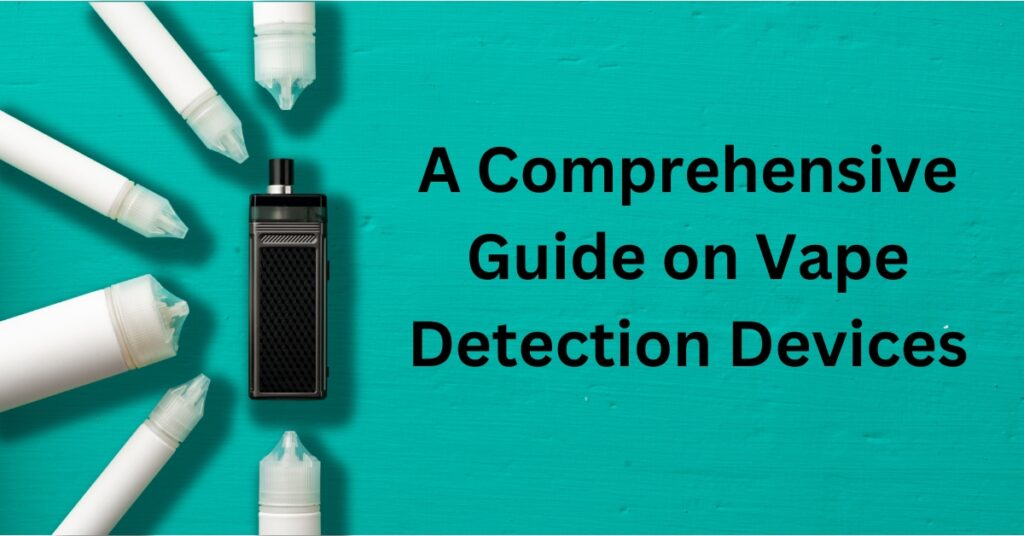Currently Empty: $0.00
How Vape Detectors Can Help Prevent Vaping in Institutions
In recent years, the rise of vaping among adolescents has become a growing concern for educational institutions, healthcare facilities, and other public spaces. The pervasive nature of this trend has prompted the need for innovative solutions to curb unauthorized vaping within these settings. One such solution gaining traction is the use of vape detectors, sophisticated devices designed to identify and prevent vaping activities. In this article, we will explore how vape detectors play a pivotal role in safeguarding institutions and maintaining a healthy environment.
Contents
What Are Vape Detectors?
Vape detectors are devices designed to detect the use of electronic cigarettes, also known as vaping devices, in specific areas. These detectors are commonly used in places where smoking or vaping is prohibited, such as schools, public buildings, and certain indoor spaces.
There are different types of vape detectors, and they typically work by sensing the chemicals or substances released during the vaping process. Some detectors use sensors to identify specific compounds found in e-cigarette vapor, while others may rely on changes in air quality or particulate matter. The goal is to identify the presence of vaping and alert authorities or personnel responsible for enforcing no-smoking or no-vaping policies.
Vape detectors may be integrated into existing security or surveillance systems, or they can be standalone devices. Some are designed to be discreet, while others are more visible as a deterrent. The technology used in these detectors is evolving, and newer models may incorporate advanced features to improve accuracy and effectiveness.
How Do Vape Detectors Solve a Growing Problem of Vaping in Schools?
Early Detection
Vape detectors are equipped with advanced sensors capable of detecting the presence of aerosol particles released during vaping. These sensors can identify the specific chemicals and particles associated with e-cigarette use, providing a means for early detection. Early identification of vaping incidents allows school administrators to intervene promptly, addressing the issue before it becomes widespread. By leveraging technology, schools can stay ahead of the curve in tackling the evolving challenges posed by student behavior.
Maintaining a Healthy Environment
Vaping poses health risks, not only to the individuals engaged in this behavior but also to those nearby. Secondhand exposure to aerosolized substances can have adverse health effects. Vape detectors contribute significantly to maintaining a healthier school environment by discouraging the use of e-cigarettes. By reducing exposure to potentially harmful chemicals, schools aim to create an atmosphere that prioritizes the well-being of both students and staff.
Preventive Measures
The mere presence of vape detectors acts as a deterrent to students who may be considering vaping on school grounds. The knowledge that their actions can be detected and addressed creates a preventive measure, dissuading students from engaging in vaping activities in the first place. Prevention is a key aspect of managing the vaping problem, and vape detectors play a crucial role in fostering a school environment where students are aware of the consequences of violating school policies related to tobacco and nicotine product use.
Educational Opportunities
The implementation of vape detectors offers an opportunity for educational initiatives. Schools can use the presence of these devices to educate students about the health risks associated with vaping, the importance of following school policies, and the potential consequences of engaging in prohibited activities. This educational component is crucial in addressing the root causes of the vaping problem, empowering students with information to make informed decisions about their health and well-being.
Parental Awareness
Vape detectors provide schools with valuable information that can be used to communicate with parents about their child’s behavior. This communication fosters parental awareness regarding the prevalence of vaping and the importance of addressing the issue collaboratively. Informed parents can play an active role in supporting school efforts to quit vaping, reinforcing the message at home and engaging in open conversations with their children about the risks associated with e-cigarette use.
What can schools do to address the vaping epidemic?
Increase Monitoring and Enforcement
Proactive monitoring and strict enforcement of anti-vaping policies are essential components of a successful prevention strategy. Schools can invest in advanced surveillance systems, employ security personnel, and utilize random checks to discourage and detect vaping incidents. Consistent enforcement sends a powerful message that the school is committed to maintaining a healthy and safe environment.
Create an Effective Vaping Policy
Developing a clear and comprehensive vaping policy is crucial for setting expectations and consequences. Schools should establish a policy that explicitly addresses the use, possession, and distribution of vaping products on school grounds. This policy should outline disciplinary actions for violations, including counseling, educational programs, and, if necessary, involvement of law enforcement. Communicating this policy to students, parents, and staff is vital to ensure everyone is aware of the consequences associated with vaping.
Educate School Staff
School staff, including teachers, administrators, and support personnel, play a crucial role in addressing the vaping epidemic. Providing comprehensive training on the signs of vaping, its health risks, and the school’s policies will empower staff to identify and address the issue effectively. Additionally, staff should be educated on how to communicate with students about the dangers of vaping and provide support to those struggling with addiction.
Educate Students
Implementing a robust educational program is key to preventing and reducing vaping among students. Schools can integrate vaping awareness into the curriculum, conduct workshops, and invite guest speakers to share personal experiences and expertise on the subject. Interactive and engaging educational initiatives, such as peer-led campaigns and creative contests, can effectively capture students’ attention and promote a positive anti-vaping culture within the school community.
In conclusion
Vape detection systems offer a comprehensive answer to the increasing issue of vaping within educational settings. For residents in Texas or other areas, professional services specializing in vape detection solutions for schools in Texas, can help to manage and curb vaping activities effectively. These systems are invaluable for detecting vaping incidents promptly, acting as a deterrent, upholding a wholesome learning atmosphere, reinforcing school regulations, delivering educational interventions, enhancing parental understanding, and allowing for adaptable configurations. While technological tools are pivotal, a well-rounded strategy encompassing education, counseling, and collaboration with parents remains vital to addressing the underlying issues of vaping and implementing a holistic approach to this growing concern in schools.



